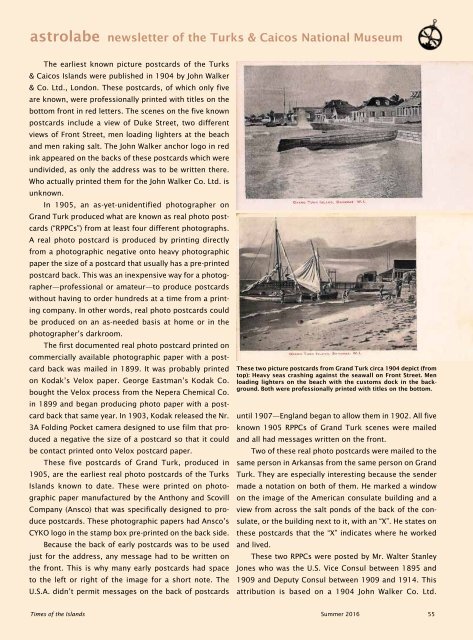Times of the Islands Summer 2016
Presents the "soul of the Turks & Caicos Islands" with in-depth features about local people, culture, history, environment, businesses, resorts, restaurants and activities.
Presents the "soul of the Turks & Caicos Islands" with in-depth features about local people, culture, history, environment, businesses, resorts, restaurants and activities.
Create successful ePaper yourself
Turn your PDF publications into a flip-book with our unique Google optimized e-Paper software.
astrolabe newsletter <strong>of</strong> <strong>the</strong> Turks & Caicos National Museum<br />
The earliest known picture postcards <strong>of</strong> <strong>the</strong> Turks<br />
& Caicos <strong>Islands</strong> were published in 1904 by John Walker<br />
& Co. Ltd., London. These postcards, <strong>of</strong> which only five<br />
are known, were pr<strong>of</strong>essionally printed with titles on <strong>the</strong><br />
bottom front in red letters. The scenes on <strong>the</strong> five known<br />
postcards include a view <strong>of</strong> Duke Street, two different<br />
views <strong>of</strong> Front Street, men loading lighters at <strong>the</strong> beach<br />
and men raking salt. The John Walker anchor logo in red<br />
ink appeared on <strong>the</strong> backs <strong>of</strong> <strong>the</strong>se postcards which were<br />
undivided, as only <strong>the</strong> address was to be written <strong>the</strong>re.<br />
Who actually printed <strong>the</strong>m for <strong>the</strong> John Walker Co. Ltd. is<br />
unknown.<br />
In 1905, an as-yet-unidentified photographer on<br />
Grand Turk produced what are known as real photo postcards<br />
(“RPPCs”) from at least four different photographs.<br />
A real photo postcard is produced by printing directly<br />
from a photographic negative onto heavy photographic<br />
paper <strong>the</strong> size <strong>of</strong> a postcard that usually has a pre-printed<br />
postcard back. This was an inexpensive way for a photographer—pr<strong>of</strong>essional<br />
or amateur—to produce postcards<br />
without having to order hundreds at a time from a printing<br />
company. In o<strong>the</strong>r words, real photo postcards could<br />
be produced on an as-needed basis at home or in <strong>the</strong><br />
photographer’s darkroom.<br />
The first documented real photo postcard printed on<br />
commercially available photographic paper with a postcard<br />
back was mailed in 1899. It was probably printed<br />
on Kodak’s Velox paper. George Eastman’s Kodak Co.<br />
bought <strong>the</strong> Velox process from <strong>the</strong> Nepera Chemical Co.<br />
in 1899 and began producing photo paper with a postcard<br />
back that same year. In 1903, Kodak released <strong>the</strong> Nr.<br />
3A Folding Pocket camera designed to use film that produced<br />
a negative <strong>the</strong> size <strong>of</strong> a postcard so that it could<br />
be contact printed onto Velox postcard paper.<br />
These five postcards <strong>of</strong> Grand Turk, produced in<br />
1905, are <strong>the</strong> earliest real photo postcards <strong>of</strong> <strong>the</strong> Turks<br />
<strong>Islands</strong> known to date. These were printed on photographic<br />
paper manufactured by <strong>the</strong> Anthony and Scovill<br />
Company (Ansco) that was specifically designed to produce<br />
postcards. These photographic papers had Ansco’s<br />
CYKO logo in <strong>the</strong> stamp box pre-printed on <strong>the</strong> back side.<br />
Because <strong>the</strong> back <strong>of</strong> early postcards was to be used<br />
just for <strong>the</strong> address, any message had to be written on<br />
<strong>the</strong> front. This is why many early postcards had space<br />
to <strong>the</strong> left or right <strong>of</strong> <strong>the</strong> image for a short note. The<br />
U.S.A. didn’t permit messages on <strong>the</strong> back <strong>of</strong> postcards<br />
These two picture postcards from Grand Turk circa 1904 depict (from<br />
top): Heavy seas crashing against <strong>the</strong> seawall on Front Street. Men<br />
loading lighters on <strong>the</strong> beach with <strong>the</strong> customs dock in <strong>the</strong> background.<br />
Both were pr<strong>of</strong>essionally printed with titles on <strong>the</strong> bottom.<br />
until 1907—England began to allow <strong>the</strong>m in 1902. All five<br />
known 1905 RPPCs <strong>of</strong> Grand Turk scenes were mailed<br />
and all had messages written on <strong>the</strong> front.<br />
Two <strong>of</strong> <strong>the</strong>se real photo postcards were mailed to <strong>the</strong><br />
same person in Arkansas from <strong>the</strong> same person on Grand<br />
Turk. They are especially interesting because <strong>the</strong> sender<br />
made a notation on both <strong>of</strong> <strong>the</strong>m. He marked a window<br />
on <strong>the</strong> image <strong>of</strong> <strong>the</strong> American consulate building and a<br />
view from across <strong>the</strong> salt ponds <strong>of</strong> <strong>the</strong> back <strong>of</strong> <strong>the</strong> consulate,<br />
or <strong>the</strong> building next to it, with an “X”. He states on<br />
<strong>the</strong>se postcards that <strong>the</strong> “X” indicates where he worked<br />
and lived.<br />
These two RPPCs were posted by Mr. Walter Stanley<br />
Jones who was <strong>the</strong> U.S. Vice Consul between 1895 and<br />
1909 and Deputy Consul between 1909 and 1914. This<br />
attribution is based on a 1904 John Walker Co. Ltd.<br />
<strong>Times</strong> <strong>of</strong> <strong>the</strong> <strong>Islands</strong> <strong>Summer</strong> <strong>2016</strong> 55

















